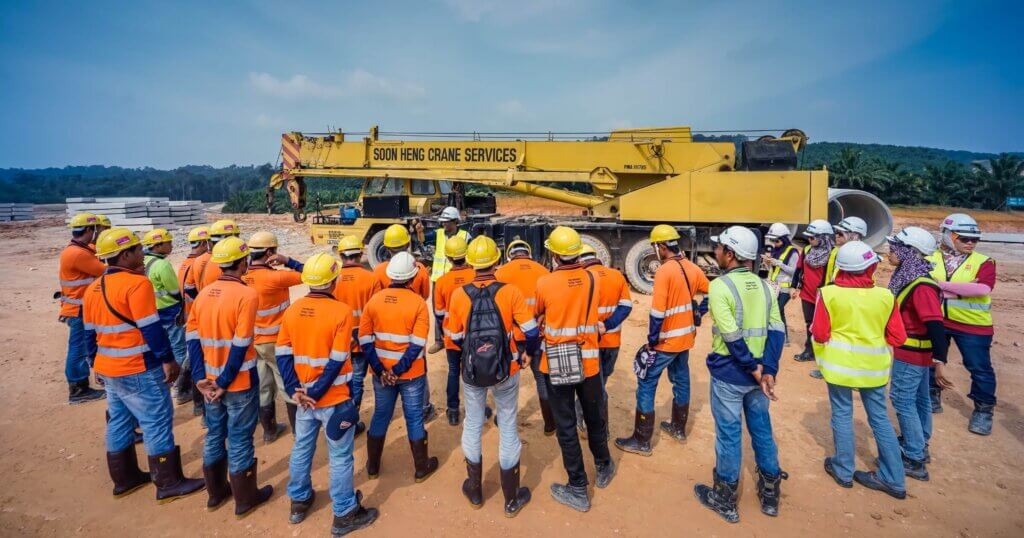Preventing injuries, meeting safety standards, and keeping everyone on the same page all starts with a proper construction safety meeting agenda. Whether you’re leading a morning toolbox talk or a scheduled safety check-in, it’s important to make it relevant to your crew what’s at stake with the work at hand. The key to making an engaging construction safety meeting agenda starts with defining a clear objective you want to achieve. Your crew should always know the why behind the safety procedure so they are motivated to keep everyone, including themselves, safe.
Here is a four step process that you can follow to create an effective safety meeting agenda for your next meeting.
Step 1: Define clear objectives and audience
Start with a specific goal in mind. Are you reviewing fall protection procedures? Talking through heat safety? Addressing a recent near-miss? Knowing the purpose of your construction safety meeting helps keep toolbox talk focused and makes it easier for your crew to stay engaged.
Tailor the topic to the roles on site. Carpenters, electricians, laborers, and equipment operators all face different types of hazards. A one-size-fits-all approach won’t be nearly as effective as a topic that speaks directly to the team you’re addressing.
Finally, make sure your safety meeting agenda lines up with any required OSHA or CSA standards. It should also reflect your company’s own safety policies and project-specific requirements.
Step 2: Prepare and plan
Keep things simple by choosing one topic per meeting. Trying to cover too much at once can water down the message. A single, focused topic is easier to present and easier for your crew to remember.
Review your talking points ahead of time so you’re confident and clear. If you can, bring props or visuals that help drive the point home. This could be a piece of PPE, a safety sign, or a quick demo using real tools from the jobsite. Seeing something in action often makes it stick.
It’s best to choose a quiet spot to hold the meeting, ideally away from equipment noise and distractions. A calm, focused setting helps your crew stay present and engaged.
It’s also ideal to make safety meetings a regular habit. Whether it’s every Monday morning or right before each shift, a consistent routine helps reinforce your company’s commitment to safety.
Step 3: Structure the meeting for active engagement

Photo courtesy of https://www.shutterstock.com/
When your construction safety meeting has a clear flow, it’s easier for the crew to stay focused and remember what’s being said. Keep it straightforward and to the point so it doesn’t feel like a waste of time.
Here’s an idea of a format to follow:
- Attendance: Take note of who is present and welcome everyone.
- Introduce the topic: Clearly explain what the meeting is about and what you want them to take away from it.
- Give context for the topic: Was there a recent incident? Are inspectors coming this week? Is there a heatwave or new equipment on site? What are the dangers and the stats behind this issue?
- Demo or presentation: If possible, show the proper use of tools, gear, or procedures with a live demo or prop.
- Engage the crew: Ask if anyone has questions, concerns, or examples from their own work.
- Summarize: Wrap up by repeating the key takeaways and explaining what comes next.
Keeping things practical and interactive will make your safety meetings feel less like a lecture and more like a valuable conversation.
If you’re looking for an easy way to get started, download our printable safety meeting agenda and start planning your next toolbox talk today.
Step 4: Follow up and track outcomes
A good construction safety meeting doesn’t end when everyone heads back to work. Taking a few minutes to follow up helps turn talk into action.
Circle back to any action items from the last safety talk. Were the right steps taken? If something slipped through the cracks, now is the time to figure out who will handle it and by when.
It is also worth keeping a simple record of each meeting. Jot down who was there, what you covered, and any concerns that came up. These notes can be helpful if issues arise later and show that you are taking safety seriously.
For your next meeting, look around the jobsite.
Is there new equipment in use? Has the weather shifted? Has someone raised a concern that should be addressed? Let the conditions on site shape what you cover. The more relevant your meetings are, the more likely your crew will pay attention and put those lessons into practice.
Key takeaways
Running an effective construction safety meeting doesn’t have to be complicated. The most important objective is to make it relevant and easy to remember:
- Focus on one clear topic that relates to real jobsite risks
- Keep each meeting short, well-structured, and easy to follow
- Use props or demonstrations, and hold a Q&A to keep the crew involved
- Record attendance and follow up on any action items
- Use a checklist or meeting template to stay organized and consistent
Want more safety tips and field-tested tools? Subscribe to our newsletter for weekly updates straight to your inbox.


